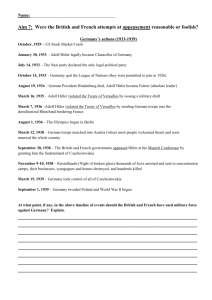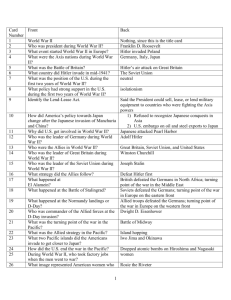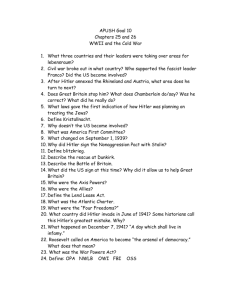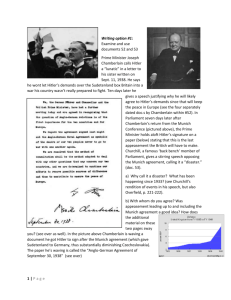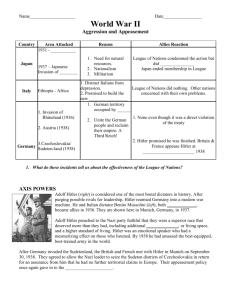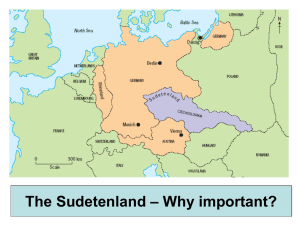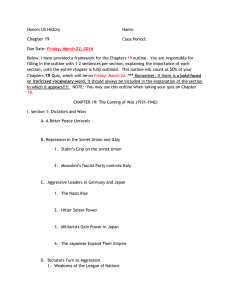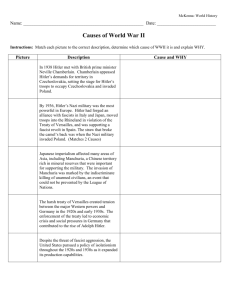0470/02 HISTORY
advertisement
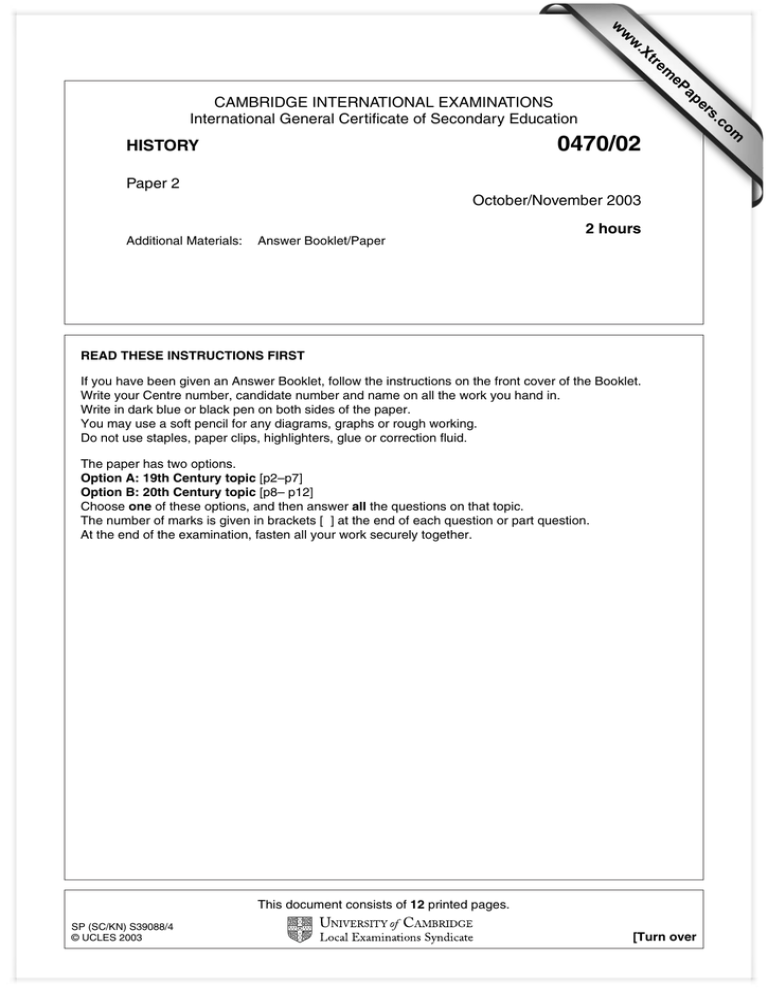
w w ap eP m e tr .X w 0470/02 HISTORY Paper 2 October/November 2003 2 hours Additional Materials: Answer Booklet/Paper READ THESE INSTRUCTIONS FIRST If you have been given an Answer Booklet, follow the instructions on the front cover of the Booklet. Write your Centre number, candidate number and name on all the work you hand in. Write in dark blue or black pen on both sides of the paper. You may use a soft pencil for any diagrams, graphs or rough working. Do not use staples, paper clips, highlighters, glue or correction fluid. The paper has two options. Option A: 19th Century topic [p2–p7] Option B: 20th Century topic [p8– p12] Choose one of these options, and then answer all the questions on that topic. The number of marks is given in brackets [ ] at the end of each question or part question. At the end of the examination, fasten all your work securely together. This document consists of 12 printed pages. SP (SC/KN) S39088/4 © UCLES 2003 [Turn over om .c s er CAMBRIDGE INTERNATIONAL EXAMINATIONS International General Certificate of Secondary Education 2 Option A: 19th Century topic DID THE JAPANESE WELCOME WESTERNISATION? Study the Background Information and the sources carefully, and then answer all the questions. Background Information In 1853 Commodore Perry arrived off the coast of Japan with four American warships. Until then Japan had been almost totally isolated from the rest of the world. America forced trading concessions from the Shogun (the Japanese ruler), who was overthrown in 1868. He was replaced by the young Emperor Meiji. Over the next fifty years the Emperor’s government embarked on a programme of modernisation. This brought with it the westernisation of much of Japanese society and culture. Did the Japanese people welcome these developments? SOURCE A I stopped at about ten places where barricades had been set up in preparation against an invasion from the sea. None of them could be depended on as a defence. If barbarian ships arrived in force, how could we defend against them? The main requirements for defence are guns and warships but the most important of them is guns. What do the so-called scholars of today actually do? Do they, after having learned the ceremonies and music, go on to discuss and learn the elements of war, or the elements of machinery? Do they make studies of conditions in foreign countries? Of setting up defence barriers? If they do, I have not heard of it. Learning a barbarian language is not only a step toward knowing the barbarians, but also the groundwork for mastering them. A Japanese author writing in 1855. He was not able to publish the book, from which this extract was taken, until after the overthrow of the Shogun. SOURCE B Japan’s progress, in the short space of half a century, has been so sudden and swift that it presents a spectacle rare in the history of the world. This leap forward is a result of coming into contact with the civilisation of Europe and America, and may well, in its broad sense, be regarded as a benefit. We possess today a powerful army and navy. We have achieved this by adopting western methods: conscription, promoting military education, encouraging the art of shipbuilding and the manufacture of arms. We have reorganised central and local government and reformed the educational system. All this is the result of adopting the superior features of western institutions. From the book ‘Fifty Years of New Japan’ by Okuma Shigenobu, published in 1908. Shigenobu had been one of the Emperor’s leading ministers. 0470/02/O/N/03 3 SOURCE C A photograph of Japanese warriors in 1868. SOURCE D A drawing of Japanese soldiers in 1904. 0470/02/O/N/03 [Turn over 4 SOURCE E A Japanese drawing from the second half of the nineteenth century showing what would happen if Japanese women married Western men. The child is the result of the marriage. SOURCE F A cartoon published in a British magazine in the second half of the nineteenth century. It shows some Japanese wearing western fashions. 0470/02/O/N/03 5 SOURCE G A cartoon published in a British magazine in 1895. It shows a Japanese soldier on top of a Chinese soldier. SOURCE H Schools, industries, armies and navies are the mere external forms of civilisation. They are not difficult to produce. All that is needed is the money to pay for them. Yet there remains something more important that cannot be bought or sold. It holds together the whole nation and its influence is so strong that without it none of the schools, industries or armies would be of the slightest use. This supremely important thing we must call the spirit of civilisation. The most important part of this spirit is independence. Fukuzawa Yukichi writing at the end of the nineteenth century. Yukichi visited America and Britain in the 1860s. During the period of modernisation in Japan he was regarded as an authority on all western matters. SOURCE I By the 1870s most of Japan’s rulers agreed that some adoption of western technology was necessary. Everyone could see the superiority of the barbarians’ artillery for example. But the Japanese were not content to be victims of the West. They resented the ‘unequal treaties’ they had been made to sign with western countries. They decided to take from the West whatever would strengthen Japan. But it was not just a question of becoming powerful. Modernisation was seen as a way to the recovery of selfrespect. In whatever mattered for the recovery of real independence, Japan was to become more western. Japan began to turn itself into an industrial nation-state but foreign investment was kept out. Japan wanted to control its own industries, and so the state paid for them. This meant heavy taxation which the discipline of Japan’s traditional society made possible. The Japanese underwent controlled westernisation, and much was deliberately left unchanged. From a British history book published in the 1980s. 0470/02/O/N/03 [Turn over 6 SOURCE J The Japanese are dismissing as rapidly as possible all foreigners they have employed to train them in western ways, from professors and schoolteachers, to engineers, draughtsmen and foremen in mills and factories. This is done partly to save money, and partly because they feel themselves capable of going it alone. A description of Japan in 1911 by an American visitor. 0470/02/O/N/03 7 Now answer all the following questions. You may use any of the sources to help you answer the questions, in addition to those sources which you are told to use. In answering the questions you should use your knowledge of the topic to help you interpret and evaluate the sources. 1 Study Sources A and B. How far do these two sources differ? Explain your answer. 2 [6] Study Sources C and D. What do these sources tell you about Japan in the second half of the nineteenth century? Explain your answer. [6] 3 Study Sources E and F. How reliable are these sources as evidence about Japanese attitudes towards the West? Explain your answer. [8] 4 Study Source G. Why was this cartoon published in 1895? Explain your answer. 5 [7] Study Sources H and I. Did the writer of Source I reach his interpretation because he had read Source H? Explain your answer. [6] 6 Study Source J. Are you surprised by what Source J describes? Explain your answer. 7 [7] Study all the sources. How far do these sources show that the Japanese welcomed westernisation? Explain your answer. [10] 0470/02/O/N/03 [Turn over 8 Option B: 20th Century topic WAS APPEASEMENT OVER THE SUDETENLAND JUSTIFIED? Study the Background Information and the sources carefully, and then answer all the questions. Background Information After Hitler had won control of Austria, he turned his attention to Czechoslovakia. Over three million Germans lived in the Sudetenland, a part of Czechoslovakia. In the summer of 1938, Hitler claimed that the Sudeten Germans were being mistreated, and he moved troops to the Czech border. Czechoslovakia appealed to Britain and France for support. The British Prime Minister, Neville Chamberlain, did everything he could to avoid war. After a series of meetings with Hitler, on 29 September at the Munich Conference, France and Britain agreed to give Hitler the Sudetenland. Were Chamberlain and Daladier, the French Prime Minister, right to appease Hitler over the Sudetenland? SOURCE A Czechoslovakia is a state created by forcing other nationalities, without asking them, into a structure manufactured at Versailles. The Czechs began to oppress and mishandle the majority of the inhabitants. Among the nationalities being oppressed are three and a half million Germans. These Germans are the creatures of God. That conditions in Czechoslovakia are unbearable is generally known. In the name of a certain President Wilson, three and a half million were robbed of their right to self-determination. Economically these people were deliberately ruined and afterwards handed over to a slow process of extermination. The misery of the Sudeten Germans is without end. Hitler speaking at a Nazi Party rally, 12 September 1938. SOURCE B You have only to look at the map of Europe to see that nothing we or France could do could possibly save Czechoslovakia from being overrun by the Germans, if they wanted to do it. The Austrian frontier is practically open. Therefore we could not help Czechoslovakia – it would simply be an excuse for going to war with Germany. The entry in Chamberlain’s diary for 20 March 1938. SOURCE C How horrible, fantastic, incredible it is that we should be digging trenches and trying on gas masks here because of a quarrel in a far away country between people of whom we know nothing. After my visits to Germany I have realised how Herr Hitler feels he must protect the other Germans, and his anger that grievances have not been resolved. He told me privately, and last night he repeated publicly, that after this Sudeten German question is settled, that is the end of Germany’s territorial claims in Europe. From Chamberlain’s radio broadcast to the people of Britain, 27 September 1938. 0470/02/O/N/03 9 SOURCE D A German cartoon published on 22 May 1938. The title of the cartoon is ‘A Czech Beer-Hall.’ In the beer-hall are the different minority peoples of Czechoslovakia. The landlord is serving them beer from the barrel labelled ‘Versailles brew’. The customers are complaining about the poor quality of the beer. SOURCE E A cartoon titled ‘Nightmare Waiting List’. It was published in a British newspaper on 9 September 1938. 0470/02/O/N/03 [Turn over 10 SOURCE F A cartoon published in a British newspaper on 25 September 1938. SOURCE G PEACE Be glad in your hearts. Give thanks to your God. The wings of peace settle about us and the peoples of Europe. The prayers of the troubled hearts are answered. People of Britain, your children are safe. Your husbands and sons will not march into battle. It was a war that nobody wanted. Nobody in Germany. Nobody in France. Nobody, above all, in Britain, which had no concern at all with the issues at stake. Through these black days, this newspaper clung to the belief that peace would prevail. Over and over again we said it, ‘There will be no European war.’ If we must have a victor, let us choose Chamberlain. For the Prime Minister’s conquests are mighty. And now let us get back to our own affairs. We have had enough of those menaces from the Continent. From a British newspaper, 30 September 1938. SOURCE H There is no doubt that Germany has the largest army outside Russia. When completely organised, her thirty-six infantry divisions alone will include 600 000 men. Britain has just over 150 000 men. No reasonable observer can doubt that, if Hitler organises his thirty-six divisions and trains 300 000 conscripts a year, in a few years’ time he will have the finest army in Europe. The French army is superior at the moment, but every year that passes makes more possible Goering’s plan of a sudden dash against Germany’s enemies. From a British book written in 1938. 0470/02/O/N/03 11 SOURCE I We ought to have gone to war in 1938. Although we were ourselves not fully prepared, we were better prepared than the enemy. September 1938 would have been the best date. Hitler speaking in February 1945. SOURCE J We have suffered a total defeat. All is over. I think you will find in a period of time Czechoslovakia will be overrun by the Nazis. We have passed an awful moment in our history, when the whole balance of power in Europe has been upset. And do not suppose this is the end. This is only the beginning of the conflict. Winston Churchill speaking in the British Parliament, October 1938. SOURCE K Why did Chamberlain and Daladier help Hitler to achieve his aims? They hoped to appease Hitler by giving him some Czech land. They wanted to direct German aggression eastwards towards the Soviet Union. In March 1939 the USSR opened talks with France and Britain to discuss ways of preventing Nazi aggression. These talks showed how unwilling Britain and France were to set up a united front against Hitler. A Soviet historian writing in 1981. 0470/02/O/N/03 [Turn over 12 Now answer all the following questions. You may use any of the sources to help you answer the questions, in addition to those sources which you are told to use. In answering the questions you should use your knowledge of the topic to help you interpret and evaluate the sources. 1 Study Source A. Why do you think Hitler made this speech in September 1938? Explain your answer. 2 [6] Study Sources B and C. Does Source B show that Chamberlain was lying to the British people in Source C? Explain your answer. [7] 3 Study Sources D and E. ‘These two cartoons prove it was right for Hitler to demand that all Germans should be united.’ How far do you agree with this statement? Explain your answer. [7] 4 Study Sources F and G. How far would the cartoonist who drew Source F have agreed with Source G? Explain your answer. [7] 5 Study Sources H and I. How far do these two sources show that Chamberlain should have gone to war over Czechoslovakia in 1938? Explain your answer. [7] 5 Study Sources J and K. Do you think that Churchill (Source J) would have agreed with the Soviet historian (Source K)? Explain your answer. [6] 7 Study all the sources. How far do these sources show that appeasement over the Sudetenland was justified? Explain your answer. [10] Copyright Acknowledgements: Option A. Source A. Option A. Source B. Option A. Source C. Option A. Source D. Option A. Source E. Option A. Source F. Option A. Source G Option A. Source H. Option A. Source J. Option B. Source A. Option B. Source B. Option B. Source C. Option B. Source D. Option B. Source E. Option B. Source F. Option B. Source G. Option B. Source H. Option B. Source I. Option B. Source K. M. Dickinson. Britain, Europe and Beyond: 1790–1900. © Reproduced by permission of Palgrave. M. Dickinson. Britain, Europe and Beyond: 1790–1900. © Reproduced by permission of Palgrave. © Getty Images (UK) Ltd. D. Wilson. People, Revolutions and Nations. Published. P. Barr. Foreign Devils. Published by Penguin. P. Barr. Foreign Devils. Published by Penguin. D. Wilson. People, Revolutions and Nations. Published. P. Barr. Foreign Devils. Reproduced by permission of Penguin. M. Dickinson. Britain, Europe and Beyond: 1790–1900. © Reproduced by permission of Palgrave. John Hills and Chris Hinton. Weimar and Nazi Germany. Published by John Murray. John Hills and Chris Hinton. Weimar and Nazi Germany. Published by John Murray. John Hills and Chris Hinton. Weimar and Nazi Germany. Published by John Murray. R. Douglas. Between the Wars: 1919–39. Published by Routledge. © Simplicissimus. David Low. © Evening Standard. News of the World. N. Kelly and R. Rees. The Modern World. Published by Heinemann Publishers Ltd. B. Walsh. Modern World. Published by John Murray. T. McAleavy. Modern World History. © Reproduced by permission of Cambridge University Press. From International Relations 1914–1995 by Tony Rea and John Wright. © 1997 by permission of Oxford University Press. Cambridge International Examinations has made every effort to trace copyright holders, but if we have inadvertently overlooked any we will be pleased to make the necessary arrangements at the first opportunity. 0470/02/O/N/03
